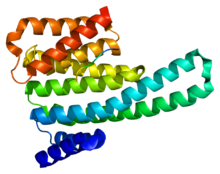- YWHAE
-
Proteína epsilon 14-3-3 
Estructura tridimensional de la proteína YWHAE.HUGO 12851 Símbolo YWHAE Símbolos alt. MDCR, MDS, KCIP-1, 14-3-3E, FLJ45465 Datos genéticos Locus Cr. 17 p13.3 Bases de datos Entrez 7531 OMIM 605066 PDB 2br9 RefSeq XP_001126863 UniProt P62258 La proteína epsilon 14-3-3 (YWHAE) es una proteína codificada en humanos por el gen ywhae.[1]
La proteína YWHAE pertenece a la familia de proteínas 14-3-3, las cuales se caracterizan por estar implicadas en la transducción de señales mediante su unión a proteínas que contengan fosfoserina. Esta familia de proteínas se encuentra altamente conservada en plantas y mamíferos y esta proteína en concreto presenta una similitud del 100% con el ortólogo de ratón. Presenta la capacidad de interaccionar con las fosfatasas CDCD25 y con las proteínas RAF1 e IRS1, sugiriendo un posible papel en diversas actividades bioquímicas relacionadas con la transducción de señales que da lugar a la división celular y a la regulación de la sensibilidad a insulina. También parece estar implicada en la patogénesis del cáncer de pulmón de células pequeñas.[2]
Interacciones
La proteína YWHAE ha demostrado ser capaz de interaccionar con:
- CDC25B[3] [4]
- Receptor de IGF-1[5]
- NGFRAP1[6]
- TGF-beta 1[7]
- HERG[8]
- c-Raf[9] [4]
- NDEL1[10]
- HDAC4[11] [12]
- IRS1[5]
- MAP3K3[13]
Véase también
- Proteína 14-3-3
Referencias
- ↑ Luk SC, Garcia-Barcelo M, Tsui SK, Fung KP, Lee CY, Waye MM (Dec 1997). «Assignment of the human 14-3-3 epsilon isoform (YWHAE) to human chromosome 17p13 by in situ hybridization». Cytogenet Cell Genet 78 (2): pp. 105–6. PMID 9371399.
- ↑ «Entrez Gene: YWHAE tyrosine 3-monooxygenase/tryptophan 5-monooxygenase activation protein, epsilon polypeptide».
- ↑ Mils, V; Baldin V, Goubin F, Pinta I, Papin C, Waye M, Eychene A, Ducommun B (Mar. 2000). «Specific interaction between 14-3-3 isoforms and the human CDC25B phosphatase». Oncogene (ENGLAND) 19 (10): pp. 1257–65. doi:. ISSN 0950-9232. PMID 10713667.
- ↑ a b Conklin, D S; Galaktionov K, Beach D (Aug. 1995). «14-3-3 proteins associate with cdc25 phosphatases». Proc. Natl. Acad. Sci. U.S.A. (UNITED STATES) 92 (17): pp. 7892–6. doi:. ISSN 0027-8424. PMID 7644510.
- ↑ a b Craparo, A; Freund R, Gustafson T A (Apr. 1997). «14-3-3 (epsilon) interacts with the insulin-like growth factor I receptor and insulin receptor substrate I in a phosphoserine-dependent manner». J. Biol. Chem. (UNITED STATES) 272 (17): pp. 11663–9. doi:. ISSN 0021-9258. PMID 9111084.
- ↑ Kimura, M T; Irie S, Shoji-Hoshino S, Mukai J, Nadano D, Oshimura M, Sato T A (May. 2001). «14-3-3 is involved in p75 neurotrophin receptor-mediated signal transduction». J. Biol. Chem. (United States) 276 (20): pp. 17291–300. doi:. ISSN 0021-9258. PMID 11278287.
- ↑ McGonigle, S; Beall M J, Feeney E L, Pearce E J (Feb. 2001). «Conserved role for 14-3-3epsilon downstream of type I TGFbeta receptors». FEBS Lett. (Netherlands) 490 (1-2): pp. 65–9. doi:. ISSN 0014-5793. PMID 11172812.
- ↑ Kagan, Anna; Melman Yonathan F, Krumerman Andrew, McDonald Thomas V (Apr. 2002). «14-3-3 amplifies and prolongs adrenergic stimulation of HERG K+ channel activity». EMBO J. (England) 21 (8): pp. 1889–98. doi:. ISSN 0261-4189. PMID 11953308.
- ↑ Vincenz, C; Dixit V M (Aug. 1996). «14-3-3 proteins associate with A20 in an isoform-specific manner and function both as chaperone and adapter molecules». J. Biol. Chem. (UNITED STATES) 271 (33): pp. 20029–34. doi:. ISSN 0021-9258. PMID 8702721.
- ↑ Toyo-oka, Kazuhito; Shionoya Aki, Gambello Michael J, Cardoso Carlos, Leventer Richard, Ward Heather L, Ayala Ramses, Tsai Li-Huei, Dobyns William, Ledbetter David, Hirotsune Shinji, Wynshaw-Boris Anthony (Jul. 2003). «14-3-3epsilon is important for neuronal migration by binding to NUDEL: a molecular explanation for Miller-Dieker syndrome». Nat. Genet. (United States) 34 (3): pp. 274–85. doi:. ISSN 1061-4036. PMID 12796778.
- ↑ Miska, E A; Langley E, Wolf D, Karlsson C, Pines J, Kouzarides T (Aug. 2001). «Differential localization of HDAC4 orchestrates muscle differentiation». Nucleic Acids Res. (England) 29 (16): pp. 3439–47. doi:. PMID 11504882.
- ↑ Grozinger, C M; Schreiber S L (Jul. 2000). «Regulation of histone deacetylase 4 and 5 and transcriptional activity by 14-3-3-dependent cellular localization». Proc. Natl. Acad. Sci. U.S.A. (UNITED STATES) 97 (14): pp. 7835–40. doi:. ISSN 0027-8424. PMID 10869435.
- ↑ Fanger, G R; Widmann C, Porter A C, Sather S, Johnson G L, Vaillancourt R R (Feb. 1998). «14-3-3 proteins interact with specific MEK kinases». J. Biol. Chem. (UNITED STATES) 273 (6): pp. 3476–83. doi:. ISSN 0021-9258. PMID 9452471.
Wikimedia foundation. 2010.
